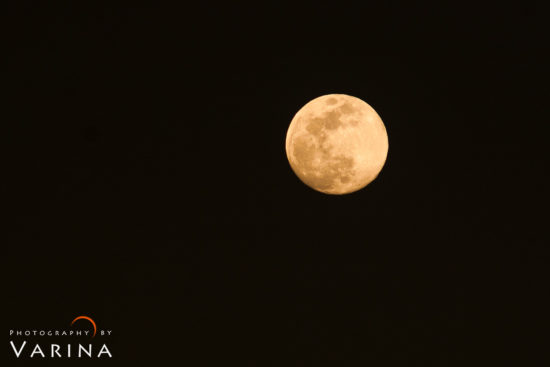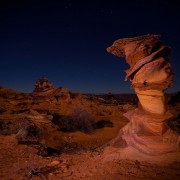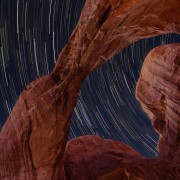Night Photography Advice for Capturing the Moon
Full moon on a clear night can create some beautiful and subtle details in the landscape. The moon is a gorgeous subject, but night photography that includes exquisite details in the moon as well as in the foreground can be tough. Have you ever photographed the moon, only to discover that it is so bright in your photograph that it appears as a small, bright spot? Or that foreground is completely black?
Night photography like the one that you see above is possible and can be hauntingly beautiful. But I created these landscape photos using two different techniques. The image from Glacier National Park is a composite image where the moon and the foreground were photography using two separate exposure and lenses. The second image from Death Valley National Park was captured using a single camera exposure using a telephoto lens. Lets take a close look at both of these techniques.
#1: Composite Night Photography Technique
I took the shot below at The Devil’s Golf Course in Death Valley National Park. A brilliant, harvest moon hung over the mountains… but my unedited photograph doesn’t show it. To capture the image I wanted, I used a “double-exposure” or blending technique. With my camera on my tripod, I took one exposure for the foreground, mountains, and sky. The scene was evenly exposed, except for the moon – so with the help of my tripod for a 30-second exposure, it was an easy shot. I used a 24mm focal length to capture the scene in the image below.
When I had the landscape shot I wanted, I prepared my setup to capture a photo of the moon. I changed lenses – choosing a 300mm focal length so I could zoom in and capture the details in the moon. The moon is properly exposed in the shot below. However, the sky is completely black, rather than the reality of it being a deep blue.
In Photoshop, I combined the two images for a finished “composite” shot. Of course, the blended image isn’t entirely true to the reality of the scene. Although, neither was the original, unedited image. My finished composite captures the feeling of that huge, golden moon over the bizarre desert landscape.

Composite night photography with moon & foreground – The Devil’s Golf Course, Death Valley National Park – California
#2: Single Camera Exposure Technique
If composite imagery isn’t your thing – I have good news for you. It is possible to capture both the moon and foreground in a single camera exposure. The trick is to photography the moon at twilight. When the light is low, you can capture the moon and the foreground with a single exposure – without blowing out the moon or leaving the landscape pitch dark.
I took this shot at Sandy Beach on Oahu just after the sun had set, but while there was still some beautiful residual light on the scene.
Here are a few useful tips that I used to photography the moon in the above photo.
- First, I used a tripod to hold my camera steady. A 1/5 sec shutter speed let me blur my moving subjects in the foreground for a bit of motion without blurring the moon.
- Next, I took a couple of test shots to make sure I had the desired focus in the foreground and in the sky. Then, I zoomed in to check the photo on the back of my camera to be sure the details in the moon were sharp.
- Additionally, I stood well back from my foreground and used a long lens – 70-200mm with a 1.4x extender. This setup let me choose a 300mm focal length, which allowed me to zoom in to show the large size of the moon as it rose. A wide angle lens delivers a tiny, little moon that gets lost in the frame.
- Pay attention to the phases of the moon when you are planning your trips. We often plan our travels around the full moon, so we can capture it in all it’s glory if the weather cooperates.
Whether you choose to create a composite shot or a single exposure image like the one from Sand Beach in Hawaii, the moon is a beautiful subject.
Do have any more tips for shooting the moon? Please share them in the comments so that others can learn! And then, get out there and shoot the moon, everyone!
















Minor detail: Wouldn’t a 70-200 mm with a 1.4 extender have a max focal length of 280mm?
Thank you for the valuable tips Varina and Jay! Would you be able to share any tips on shooting the moon using a Smartphone? I own a Google Pixel 3 phone and I know the camera on this phone produces fantastic shots, for what it’s worth for Smartphone photography. I wonder if you might know of any tips that I can try the next time I get to shoot the moon. Thanks a bunch!
I have seen few photos…but never really tried that. We will see if we can put an article about Smartphone up for our audience.
All you need to take a photo of the moon:
-Know the phases of the moon
-Correctly choose the time of shooting
-Fill the frame
-Use foreground
– Reduce vibration to sharpen
-Determination of the correct camera settings
– Tricks Photoshop
voila and you have a gorgeous moon
This is my Exposure Settings for the Moon shoot
◦ Aperture f5.6 Shutter 1/250 ISO 400
◦ Aperture f8 Shutter 1/125 ISO 200
The evening before the full moon day is best for this type of photography
Thanks for the most valuable tip.
I agree a full moon shows rather flat surface. I would always recommend couple of days before or after full moon to capture the details of craters. I also suggest at least a 600 mm lense. Any thing less needs too much cropping and you will loose the details. Stay with simple settings – f9 or f10, ISO 100, 1/100. Take few shots by playing around with the f-stop some will certainly come out good. An evening sky which is deep blue makes a great background.
Thanks for a great tip!!
Thanks for sharing Varina! I follow yourself and Jay, and I’m appreciative of the information you share with those of us trying to sharpen our skills. Of course with Photography being a hobby rather than our career, we don’t often get the time as you do to find that ‘constant’ use of our camera’s which heightens our experience overall, yet the excitement of getting out when we can, and use the tips and tricks we find through folks such as yourself are helpful and important.
The great thing about the composite method is, once you take one really good image of the moon, you can save it and then paste it into just about any shot! My images have improved dramatically since I learned more about layers and compositing.
Just a heads-up that the email that brought me here described your photo from Zabriskie Point as a moon rising at sunset, when from the direction you were facing it is clear it is a photo of the moon setting near sunrise.